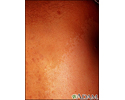Patchy skin color
Dyschromia; Mottling
Patchy skin color is areas where the skin color is irregular with lighter or darker areas. Mottling or mottled skin refers to blood vessel changes in the skin that cause a patchy appearance.
Considerations
Irregular or patchy discoloration of the skin can be caused by:
- Changes in melanin, a substance produced in the skin cells that gives skin its color
- Growth of bacteria or other organisms on the skin
- Blood vessel (vascular) changes
- Inflammation due to certain rashes
The following can increase or decrease melanin production:
- Your genes
- Heat
- Injury
- Exposure to radiation (such as from the sun)
- Exposure to heavy metals
- Changes in hormone levels
- Certain conditions such as vitiligo
- Certain fungal infections
- Certain rashes
Exposure to sun or ultraviolet (UV) light, especially after taking a medicine called psoralens, may increase skin color (pigmentation). Increased pigment production is called hyperpigmentation, and can result from certain rashes as well as sun exposure.
Decreased pigment production is called hypopigmentation.
Skin color changes can be their own condition, or they may be caused by other medical conditions or disorders.
How much skin pigmentation you have can help determine which skin diseases you may be more likely to develop. For example, lighter-skinned people are more sensitive to sun exposure and damage. This raises the risk of skin cancers. But even in darker-skinned people, too much sun exposure can lead to skin cancers.
Examples of the most common skin cancers are basal cell carcinoma, squamous cell carcinoma, and melanoma.
Generally, skin color changes are cosmetic and do not affect physical health. But, mental stress can occur because of pigment changes. Some pigment changes may be a sign that you are at risk for other medical problems.
Causes
Causes of pigment changes may include any of the following:
- Acanthosis nigricans
- Acne
- Cafe-au-lait spots
- Cuts, scrapes, wounds, insect bites, and minor skin infections
- Erythrasma
- Melasma (chloasma)
- Melanoma
- Moles (nevi), bathing trunk nevi, or giant nevi
- Dermal melanocytosis
- Pityriasis alba
- Radiation therapy
- Rashes
- Sensitivity to the sun due to medicine reactions or certain medicines
- Sunburn or suntan
- Tinea versicolor
- Unevenly applying sunscreen, leading to areas of burn, tan, and no tan
- Vitiligo
Home Care
In some cases, normal skin color returns on its own.
You may use medicated creams that bleach or lighten the skin to reduce discoloration or to even the skin tone where hyperpigmented areas are large or very noticeable. Check with your health care provider first about using such products. Follow the instructions on the package about how to use such products.
Selenium sulfide (Selsun Blue), ketoconazole, or tolnaftate (Tinactin) lotion can help treat tinea versicolor, which is a fungal infection that can appear as hypopigmented patches. Apply as directed to the affected area daily until the discolored patches disappear. Tinea versicolor often returns, even with treatment.
You may use cosmetics or skin dyes to hide skin color changes. Makeup can also help hide mottled skin, but it will not cure the problem.
Avoid too much sun exposure and use sunblock with an SPF of at least 30. Hypopigmented skin sunburns easily, and hyperpigmented skin may get even darker. In darker-skinned people, skin damage may cause permanent hyperpigmentation.
When to Contact a Medical Professional
Contact your provider if:
- You have any lasting skin color changes that do not have a known cause
- You notice a new mole or other growth
- An existing growth has changed color, size, or appearance
What to Expect at Your Office Visit
Your provider will carefully examine your skin and ask about your medical history. You will also be asked about your skin symptoms, such as when you first noticed your skin color change, if it started suddenly, and if you had any skin injuries.
Tests that may be done include:
- Scrapings of skin lesions
- Skin biopsy
- Wood lamp (ultraviolet light) exam of the skin
- Blood tests
Treatment will depend on the diagnosis of your skin problem.
References
Calonje E, Brenn T, Lazar AJ, Billings SD. Disorders of pigmentation. In: Calonje E, Brenn T, Lazar AJ, Billings SD, eds. McKee's Pathology of the Skin. 5th ed. Philadelphia, PA: Elsevier; 2020:chap 20.
Patterson JW. Disorders of pigmentation. In: Patterson JW, ed. Weedon's Skin Pathology. 5th ed. Philadelphia, PA: Elsevier; 2021:chap 11.
Ubriani RR, Clarke LE, Ming ME. Non-neoplastic disorders of pigmentation. In: Busam KJ, Goldblum JR, eds. Dermatopathology. 2nd ed. Philadelphia, PA: Elsevier Saunders; 2016:chap 7.
Acanthosis nigricans - close-up - illustration
Acanthosis nigricans - close-up
illustration
Acanthosis nigricans on the hand - illustration
Acanthosis nigricans on the hand
illustration
Neurofibromatosis - giant cafe-au-lait spot - illustration
Neurofibromatosis - giant cafe-au-lait spot
illustration
Vitiligo - drug induced - illustration
Vitiligo - drug induced
illustration
Vitiligo on the face - illustration
Vitiligo on the face
illustration
Halo nevus - illustration
Halo nevus
illustration
Acanthosis nigricans - close-up - illustration
Acanthosis nigricans - close-up
illustration
Acanthosis nigricans on the hand - illustration
Acanthosis nigricans on the hand
illustration
Neurofibromatosis - giant cafe-au-lait spot - illustration
Neurofibromatosis - giant cafe-au-lait spot
illustration
Vitiligo - drug induced - illustration
Vitiligo - drug induced
illustration
Vitiligo on the face - illustration
Vitiligo on the face
illustration
Halo nevus - illustration
Halo nevus
illustration
Review Date: 5/28/2024
Reviewed By: Ramin Fathi, MD, FAAD, Director, Phoenix Surgical Dermatology Group, Phoenix, AZ. Also reviewed by David C. Dugdale, MD, Medical Director, Brenda Conaway, Editorial Director, and the A.D.A.M. Editorial team.























